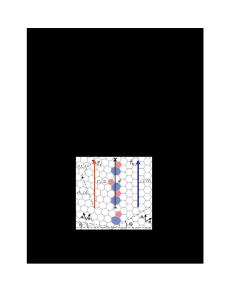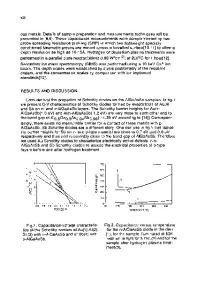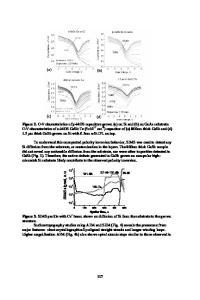Effect of Morphology on the Electrical Transport Properties of Polyaniline Films for Electronic Applications
- PDF / 322,590 Bytes
- 6 Pages / 414.72 x 648 pts Page_size
- 41 Downloads / 358 Views
L
Jl~-y
J
Figure 1. The chemical structure of polyaniline. Electrical transport properties of chemically prepared polyaniline show a strong temperature dependence. In general, depending on the sample preparation and dopant species 3'4, 365 Mat. Res. Soc. Symp. Proc. Vol. 488 © 1998 Materials Research Society
the polymers may be metallic, insulating, or be in the critical region for a metal-insulator transition. It is also known that disorder plays a predominant role in the transport process. The disorder can be homogeneous on a molecular scale, mesoscopic heterogeneities with highly doped conducting clusters, or crystalline islands separated by insulating regions. The DC conductivity is thus influenced to a great deal by the extent of amorphous regions. However, because of the absence of a measuring current flow, the thermoelectric power is less dependent on these regions. Several models have been proposed for describing the temperature dependence and transport properties of charge carriers, including quasi-one dimensional variable range hopping (Q-ID VRH) 5, charging energy limited tunneling for granular metals 6, and three dimensional variable range hopping with a Coulomb gap 7. The goal of the present work is to elucidate the interconnection between structure, both molecular (i.e. oxidation state) and morphological, and electrical transport properties. The techniques employed for this study are differential scanning calorimetry for characterization of thermal transitions, and temperature dependence of conductivity and thermoelectric power. Experimental Polyaniline was chemically synthesized by addition of an ammonium persulfate solution (in 1.0 M HCI) to a stirred aniline solution (in 1.0 M HCI) over two and a half hours. The temperature of the reaction mixture was controlled at -30 OC. LiCl (6.0 M) was present to prohibit freezing. For this reaction, the aniline:oxidant molar ratio was 2:1. The total reaction time was 24 hours after which the resultant emeraldine salt was washed with 6.0 L of deionized water. The emeraldine salt was deprotonated by stirring in 3 wt% NH 4 OH for 25 hours and washed with 6.0 L deionized water. Oligomer was removed by stirring the emeraldine base in methanol for 45 minutes followed by rinsing with 6.0 L methanol. Gel permeation chromatography (polystyrene standards, N-methyl-2-pyrrolidinone/0.05 M LiBr as eluent, 80 "C) was employed to determine the molecular weight of the emeraldine base (Mn=32,000 and
Mw=60,000). Solutions (9 wt%) of the emeraldine base were prepared in N,N'-dimethyl propylene urea (DMPU) containing varying amounts of phenyl hydrazine. The molar ratios of phenyl hydrazine to emeraldine base (based on a four ring repeat unit) were R = 0.0, 0.36, 0.71, and 1.11. These solutions were spin coated onto silicon wafers at a spinning speed of 500 rpm and a spinning time of 30 seconds on a Headway Research Inc., PM1OIDT-R790 spin coater. These films were then placed on a heating plate for 10 minutes at -75 'C. The' films were removed from the substrate by submersio
Data Loading...










